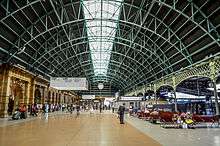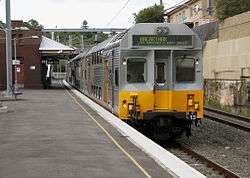Sydney Trains
 | |
|
Sydney Trains A set at Central station in July 2013 | |
| Overview | |
|---|---|
| Locale | Sydney |
| Transit type | Suburban rail |
| Number of lines | 7 |
| Number of stations | 178 |
| Annual ridership | 322 million in 2015-16 |
| Website | Sydney Trains |
| Operation | |
| Began operation | 1 July 2013 |
| Technical | |
| System length | 815 km (506 mi)[1] |
| Track gauge | 1,435 mm (4 ft 8 1⁄2 in) standard gauge |
| Electrification | 1500 V (DC) overhead line |
Sydney Trains is the suburban passenger rail network serving the city of Sydney, New South Wales, Australia. The network is a hybrid suburban-commuter railway with a central underground core that covers over 815 km (506 mi) of track and 178 stations over 7 lines. The network has 21 hours a day operation with train frequencies of every three minutes or better in the underground core, 5–10 minutes at most major stations all day, 15 minutes at most minor stations all day and four trains an hour on the Cumberland Line. During weekend services trains are less frequent with headways of upwards of a half-hour on outer stations with frequencies of less than 10 minutes in the underground core.[2]
The network is controlled by the New South Wales Government's transport authority, Transport for NSW, and is part of the authority's Opal ticketing system. In 2015-16, 322 million passenger journeys were made on the network.[3]
History
The Sydney Trains network is operated by a government owned organisation–also called Sydney Trains–that replaced the previous government operator, RailCorp. In May 2012 the Minister for Transport announced a restructure of RailCorp.[4][5][6][7] This resulted in all suburban services in the Sydney Metropolitan area bounded by Berowra, Emu Plains, Macarthur and Waterfall transferring from RailCorp's CityRail division to Sydney Trains on 1 July 2013. Intercity and Hunter Line services previously operated by CityRail are now operated by NSW TrainLink which was also formed as part of the restructure.[8] RailCorp was left as the owner of the network infrastructure.

In April 2013 the Sydney Trains logo was unveiled.[9]
Network changes
The first expansion of the Sydney suburban network during the Sydney Trains era occurred in 2015 when the South West Rail Link opened between Glenfield and Leppington. The network will reduce in size over the coming years as sections of the network are transferred to the city’s metro and light rail networks. The line between Chatswood and Epping will form part of Sydney Metro Northwest and will close for conversion in 2018.[10] The section of line between Sydenham and Bankstown will form part of the Sydney Metro City & Southwest. This is due to open in 2024.[11] The section of line between Camellia and Carlingford will form a branch of the Parramatta Light Rail network. Construction of this project is expected to commence in late 2018. There has been no announcement of an expected completion date for the project.[12]
Patronage
The following table lists patronage figures for the network (in millions of journeys) during the corresponding financial year. Australia's financial years start on 1 July and end on 30 June. Major events that affected the number of journeys made or how patronage is measured are included as notes.
| 2013-14[13] | 2014-15[13] | 2015-16[14] |
|---|---|---|
| 282.2[note 1] | 291.9[note 2] | 322 |
Network
Rail Lines
Sydney Trains operates seven suburban lines across metropolitan Sydney.
In conjunction with a new timetable released on 20 October 2013, the Sydney Trains network was reorganised with a new numbering system. The number of lines was reduced from eleven to seven by grouping some lines together.
| Line colour, number and name | Between | |
|---|---|---|
| North Shore, Northern & Western Line |
Central and Berowra via Gordon | |
| Airport, Inner West & South Line |
City Circle and Macarthur via Revesby and either Sydenham (peak) or Airport | |
| Bankstown Line | City Circle and Liverpool or Lidcombe via Bankstown and Sydenham | |
| Eastern Suburbs & Illawarra Line | Bondi Junction and Waterfall or Cronulla via Central | |
| Cumberland Line | Schofields and Campbelltown | |
| Carlingford Line | Clyde and Carlingford | |
| Olympic Park Line | Lidcombe and Olympic Park, some services operate between Central and Olympic Park, particularly during special events | |


The main hub of the Sydney Trains system is Central Station, which most lines pass through. Central is also the terminus of most NSW TrainLink lines. After leaving Central, trains coming from the T2 Airport, Inner West & South Line and T3 Bankstown Line then travel through the City Circle - a ring line serving the Sydney Central Business District. After completing the City Circle, these trains pass through Central for a second time and return to the suburbs. The T1 North Shore, Northern & Western Line and T4 Eastern Suburbs and Illawarra Line pass through the Central Business District and continue on to other areas of Sydney. The T5 Cumberland Line serves Western Sydney and provides access to the major centre of Parramatta from the south west of the city without requiring a change of trains at Granville. The T6 Carlingford Line and T7 Olympic Park Line are suburban shuttle services.
NightRide
To provide a passenger service between midnight and 05:00 while leaving the tracks clear of trains for maintenance work, parallel bus services were established in 1989. NightRide services operate typically at hourly intervals (some routes depart more frequently on weekends). NightRide services are contracted to private bus operators, and identified by route numbers beginning with "N".
Operations
In July 2013 Howard Collins OBE the former Chief Operating Officer from London Underground was appointed as Chief Executive of Sydney Trains. In addition to operating suburban train services, Sydney Trains maintains the New South Wales Metropolitan Rail Area, and maintains all but a handful of operational railway stations in the state. Sydney Trains is a wholly owned subsidiary of the Transport for New South Wales (TfNSW) statutory authority.[15]
Fleet


Sydney Trains operates a fleet of S (192 carriages), K (160 carriages). C (56 carriages), T (447 carriages), M (140 carriages), and A sets (626 carriages).
The Sydney Trains network is divided into three sectors, based around three maintenance depots.[16] EMU trainsets are identified by target plates, which are exhibited on the front lower nearside of driving carriages.[17] Target designations and set numbers are used in identifying EMU train sets. A sets do not have a target plate, but instead have the set number written directly on the front of the train. The composition and formations of train sets, and the target designations are subject to alteration.
| Sector # | Depot | Serviced lines | Target plate | Fleet |
|---|---|---|---|---|
| 1 | Mortdale | Eastern Suburbs & Illawarra | Red | T |
| 2 | Flemington | Airport, Inner West & South, Bankstown, Carlingford, Cumberland and Olympic Park | Blue | S, K, C, V |
| 3 | Hornsby | North Shore, Northern & Western | Black | T, K |
| N/A | Eveleigh | Airport, Inner West & South, Bankstown (M sets)
Blue Mountains, South Coast and Central Coast Lines & Sector 3 (H sets) |
Green | M, H |
| N/A | Auburn | All suburban lines except Eastern Suburbs & Illawarra, Cumberland and Carlingford | N/A | A |
Ticketing and Costs
Sydney Trains currently uses the Opal ticketing system which was introduced to the network in April 2014.[18] The fare system is fully integrated with the NSW TrainLink Intercity network - trips involving both suburban and intercity services are calculated as a single fare and there is no interchange penalty. Opal is also valid on bus, ferry and light rail services but separate fares apply for these modes. The following table lists Opal fares for reusable smartcards and single trip tickets:
| Train | 0–10 km | 10–20 km | 20–35 km | 35–65 km | 65 km+ |
|---|---|---|---|---|---|
| Adult cards (peak) | $3.38 | $4.20 | $4.82 | $6.46 | $8.30 |
| Adult cards (off-peak) | $2.36 | $2.94 | $3.37 | $4.52 | $5.81 |
| Other cards (peak) | $1.69 | $2.10 | $2.41 | $3.23^ | $4.15^ |
| Other cards (off-peak) | $1.18 | $1.47 | $1.68 | $2.26 | $2.90^ |
| Adult single trip | $4.10 | $5.10 | $5.80 | $7.80 | $10.00 |
| Child/Youth single trip | $2.00 | $2.50 | $2.90 | $3.90 | $5.00 |
^ = $2.50 for Pensioner/Senior cardholders
Card fares as of 4 January 2015. Single trip fares as of 5 September 2016.[19][20]
The previous ticketing system was introduced in 1992 and was based on magnetic stripe technology. It was shut down on 1st August 2016.[21]
Unlike the ticketing systems of other cities in Australia, most of Sydney Trains's ticket prices are calculated on the distance travelled, and were found to be inexpensive by world standards as at December 2003.[22] However, in October 2012, a report published by PwC found the rail system performed poorly compared to many metro services from 27 other major world cities. Sydney was ranked as the fourth-worst public train system, beating only Los Angeles, São Paulo and Johannesburg for operation efficiency and coverage, while being proven to have the most expensive tickets of any major city public transport system. An update to the same Cities of Opportunity report in 2014 - after the roll out of the Opal card - has shown a drop to 2nd most expensive system after London. Despite fares having only seen increases since this roll out, the card does afford regular users 'rewards' such as free train journeys after a certain number of rides and daily cap limits.
Entry to privately owned train stations at Sydney Airport requires a Station Access Fee in addition to the train fare. This station access fee does not apply for Green Square and Mascot.[23]
See also
References
- ↑ "Transport for NSW 2013/14 Annual Report" (pdf). Transport for NSW. p. 32.
- ↑ "Timetables". Sydney Trains.
- ↑ "Sydney Trains 2015-16 Annual Report Volume 1" (pdf). Sydney Trains. p. 3.
- ↑ "RailCorp job cuts first of many: unions" Sydney Morning Herald 15 May 2012
- ↑ "Ruthless RailCorp reforms planned as middle management axed" Daily Telegraph 15 May 2012
- ↑ Corporate Plan 2012/13 RailCorp
- ↑ 700 jobs to go as RailCorp gets the axe Daily Telegraph 16 November 2012
- ↑ About the Reform Sydney Trains
- ↑ Fixing the Trains: New approach to customer service Transport for NSW 18 April 2013
- ↑ "Epping to Chatswood upgrade overview". Transport for NSW. Retrieved 27 July 2016.
- ↑ "Sydney Metro". Transport for NSW. Retrieved 27 July 2016.
- ↑ "Parramatta Light Rail". Transport for NSW. Retrieved 27 July 2016.
- 1 2 "Transport for NSW Annual Report 2014-15" (PDF). Transport for NSW. p. 131. Retrieved 1 August 2016.
- ↑ "Sydney Trains 2015-16 Annual Report Volume 1" (pdf). Sydney Trains. p. 3.
- ↑ Annual Report 30 June 2012 RailCorp
- ↑ "Train Fleet Maintenance". CityRail. 1 June 2006. Archived from the original on 13 March 2008. Retrieved 18 May 2008.
- ↑ Department of Railways, New South Wales: Working of Electric Trains, 1965
- ↑ https://www.opal.com.au/en/about-opal/what-services-can-i-use-it-on/Trains/
- ↑ "New fares from 4 January 2015". transportnsw.info. Transport for NSW. 5 December 2014. Archived from the original on 25 December 2014.
- ↑ "Fares and benefits". opal.com.au. Transport for NSW. Retrieved 13 September 2016.
- ↑ "No more paper tickets | NSW Government | Opal". www.opal.com.au. Retrieved 2016-07-20.
- ↑ Ministerial Inquiry into Sustainable Transport in New South Wales, Transport NSW. December 2003.
- ↑ "CityRail – Tickets & Fares". RailCorp. 9 June 2009. Retrieved 9 June 2009.
_departing_Central_Station_(2).jpg)